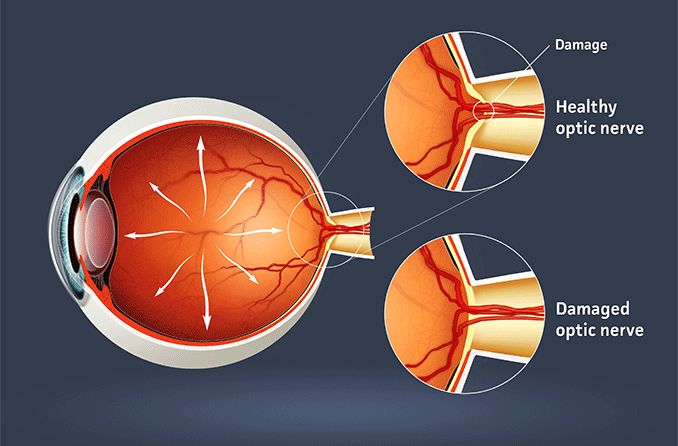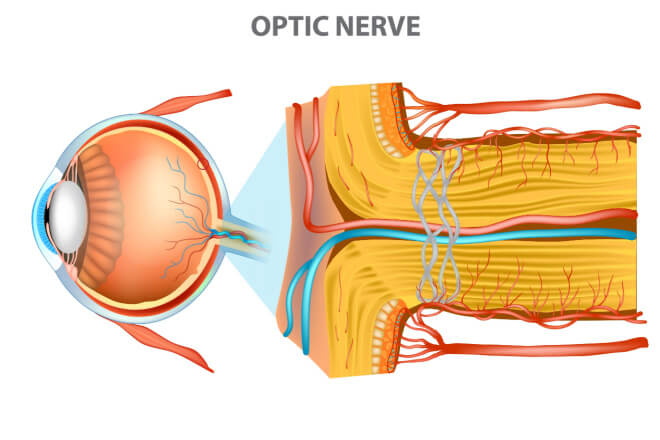Optic nerve: Anatomy, function and conditions

The optic nerve is located in the back of the eye and connects the eye to the brain. Impulses produced by the retina are sent to the brain via the optic nerve, where the impulses are developed into images.
Optic nerve definition
The optic nerve is the nerve that carries information from the eye to the brain. It’s the second of 12 cranial nerves, which include the olfactory nerve, oculomotor nerve, facial nerve and others. For this reason, the optic nerve is also called the second cranial nerve or cranial nerve II.
Optic nerve anatomy
The optic nerve is located at the very back of the eye, attached to the retina. Because of its function, the optic nerve is considered part of the nervous system, even though it’s located in the eye.

The Optic Nerve (cranial nerve II)
Nerve (ganglionic) cells as well as millions of nerve fibers make up the optic nerve. During an eye exam, your doctor can perform an ophthalmoscopy to easily view the head of the optic nerve, called the optic disc. This part of the optic nerve is an extension of the brain, making it the only part of the brain that can be visible from the outside.
SEE RELATED: What part of the brain controls vision?
Optic nerve function
Normal optic nerve function is to send signals from the eye to the brain, working as a messenger to help us determine what we see.
When light enters the eye, the cornea tries to focus it directly on the retina in order to get the clearest image. The retina senses the light and uses it to create impulses or currents. The optic nerve takes the current and sends it up to the brain, where it’s registered as an image.
While the job of the optic nerve seems simple, it’s a vital part of our ability to make sense of the world around us. So vital, in fact, that scientists are working to create a machine to provide the same function of the optic nerve in an attempt to restore vision lost to people with optic nerve damage.
A team of engineers, scientists and medical researchers in Australia known as Monash Vision Group (MVG) have developed prototype headgear that produces bionic vision. The headgear consists of implants that use wireless technology to stimulate the visual cortex of the brain.
If successful, MVG’s bionic vision system can make it possible to restore sight for people with total blindness.
SEE RELATED: Abducens nerve
Optic nerve problems
When a problem develops in the optic nerve — by trauma, disease or exposure to harmful elements — the effect it has on vision may be presented in different ways:
Vision loss on one side. This is caused by nerve damage that was contained to the one affected eye.
Loss of peripheral vision in both eyes. Results from damage to the space behind the eyes where the optic nerves meet (optic chiasm).
Vision loss on one side of the visual field in both eyes (damage on the left side of the brain would cause loss of the right visual field in both eyes). Caused by damage to the pathway that connects the optic chiasm to the part of the brain that registers visual information.
SEE RELATED: Ischemic optic neuropathy (ION)
Conditions that may result in optic nerve problems include:
Glaucoma – A group of conditions that describe damage to the optic nerve. Usually caused by elevated pressure within the eye. If untreated, vision may be lost.
Optic neuritis – Inflammation of the optic nerve caused by infection or immune system problems associated with conditions like multiple sclerosis.
Coloboma of optic nerve – Congenital abnormality where the optic nerve is not completely formed, or part of the optic nerve is missing. One or both eyes may be affected.
Optic nerve atrophy – Damage to the optic nerve caused by trauma, disease, poor blood flow to the eye, or exposure to toxic substances.
Optic nerve drusen – Pockets of protein and calcium salts that gradually accumulate in the optic nerve.
Optic nerve pit – Congenital defect that causes a dip or depression in the optic disc.
Neuromyelitis optica – Condition where antibodies and immune system cells attack the protective coating around nerve fibers in the central nervous system (myelin).
Idiopathic intracranial hypertension – Abnormal collection of cerebrospinal fluid (the fluid surrounding the brain and spinal cord) in the skull, causing increased pressure on the brain.
Septo-optic dysplasia – Disorder of early brain development that results in underdeveloped optic nerves.
Toxic amblyopia (nutritional amblyopia) – Damage to the optic nerve caused by undernutrition or exposure to dangerous substances, such as lead, methanol, antifreeze or certain drugs.
SEE RELATED: What is hypertensive retinopathy
Importance of routine eye exams
Routine eye exams are an easy and important way to make sure your vision is in tip-top shape. During an eye exam, your eye doctor can assess the health of your optic nerve and evaluate any symptoms you may be experiencing.
If the eye doctor sees a problem related to the optic nerve, they may refer you to a neuro-ophthalmologist for more specialized treatment.
READ MORE: Papilledema (optic nerve swelling)
Page published on Tuesday, February 16, 2021






